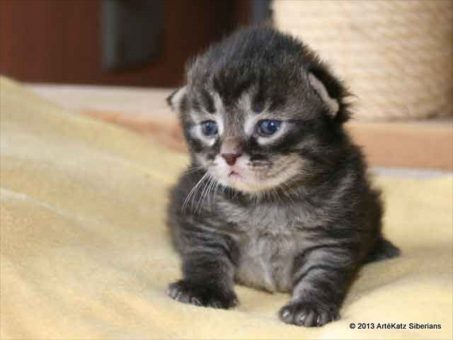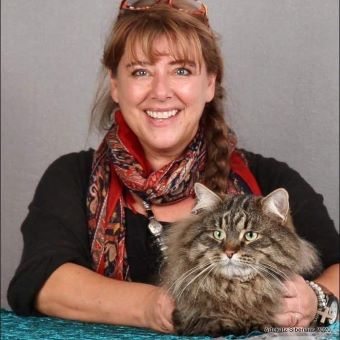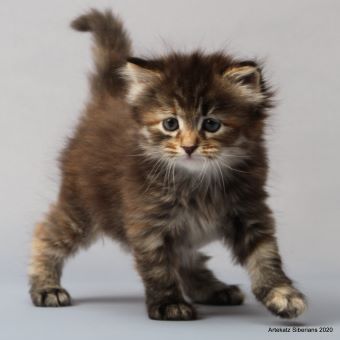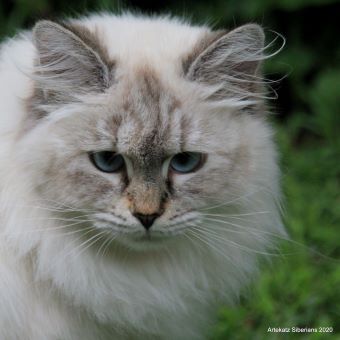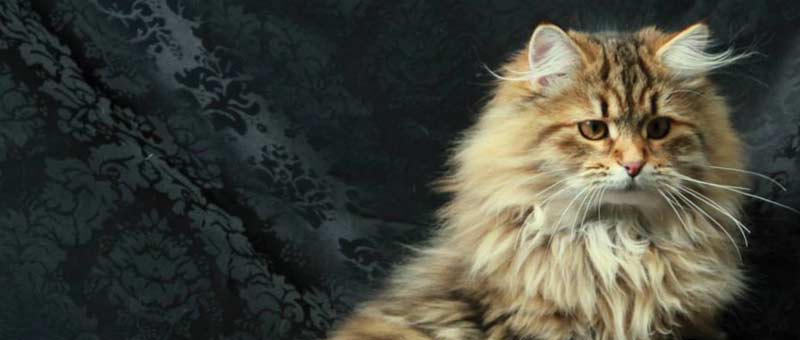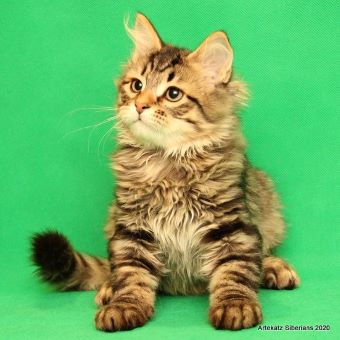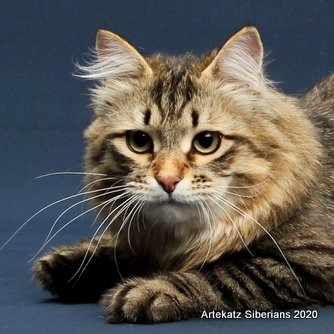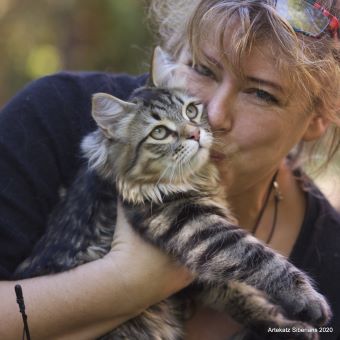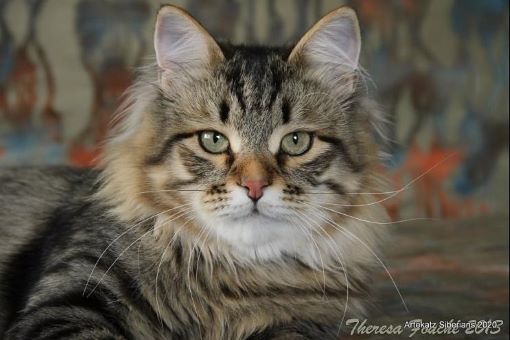FAQ's for Cat Owners
Purring in cats is a sign of pleasure and feeling content. It can however also be a sign that the cat is injured or feeling unwell and is trying to heal itself. The purring causes a resonance frequency in the body that helps heal the cat, so interpreting purring depends on the situation.
Some cats don’t purr, but most do and especially when they are sleeping or have just woken up and you stroke them, they are inclined to purr.
Cats are naturally nocturnal, so will always be awake at some point during the night. One can however train cats to sleep in, as I do with my kittens, from around 10 PM to around 6 AM (later in winter). If they wake you at 2 AM, just ignore them. Turn over and put your hand on them gently and go back to sleep. Whatever you do, do NOT feed them or give them a snack or play with them during the night, this will condition them to wake you up at night.
We start feeding our kittens their first solids around 4-5 weeks and start off with minced rabbit and beef mince.
As cats are obligate carnivores and can live on a 100% protein diet, feeding cats raw food is the most natural way to give them a long and healthy life. It is however crucial to understand that cats cannot survive on one type of meat or organ, they need a balanced meal, which consists of meat, internal organs and bones, as they would get when eating a bird or rat.
There are many companies today providing raw food and our cattery gets theirs from Raw Love, where cat and dog food can be ordered online and is delivered in frozen portions directly to your doorstep. Complete rabbit or chicken minced (without skin or feathers) is considered a complete meal, minced heart, chicken necks, etc. are supplementary meals. Kittens get fed 3 times a day until about 6 months, adults twice a day.
Never leave food down for cats, raw food should be picked up again after the cat has finished eating and kibble only given as treats. We treat kibbles like junk food, use it to call the cats into the house in the evening (shake the tin and they are there in flash) and to reward them.
Kibble (dry food) is NOT FOOD!
The main cause of death in cats is renal failure. Cat’s eat raw food in nature and hence instinctively do not drink a lot of water, as they get most of their moisture from the food. Feeding them dehydrated pellets that suck up moisture in their digestive system requires them to drink a lot more water, which many don’t do, and so they are not properly hydrated over long periods of time.
We seen several of our cats we sold that had been changed over to dry food with allergies, hair loss and poor condition.
When switching back to raw, these symptoms disappeared.
Kibble contains taste enhancers, so cats love them, even get addicted to them, so they are a great treat (still get a good brand here) but should not be the main food you provide to your cat.
Contrary to common belief, cats do not naturally drink milk (where would they get this in nature?) but most will drink it when offered. Siberians particularly like drinking flowing water, from a tap or a pet fountain.
For new born kittens that the mother is not feeding or for sick cats, I create a mixture I call Gloop, the recipe is below. This can be given via syringe into the mouth or just put in a bowl for normal drinking. This is very high in calories to nourish and put on weight.
Also good in summer as an ice cream when its really hot.
GLOOP
1 tin evaporated milk (not condensed!)
Equal amount of boiling water, in which a teaspoon of honey has been dissolved
2 egg yolks (not the whites)
1 tablespoon full fat mayonnaise (Hellmans)
2 tablespoons of LIVE full fat, plain yoghurt (bio)
1 teaspoon probiotic powder (from pet or vet shops)
Mix the egg yolks together, add mayonnaise and yoghurt, mix well. Add probiotic powder if available, slowly mixing in the evaporated milk, then add the water/honey mix.
Make sure you keep stirring/shaking this during use as all the sediment will drop to the bottom. You can put this into ice cube trays and it will keep for 3 months in the freezer, about a week in the fridge.
Siberians only shed twice a year, in spring and autumn. In those few weeks they need regular brushing. The earlier you start brushing your cat, the more likely it will enjoy this.

For cats that don’t, having one person keep the head busy while the other brushes can work, or giving it something to chew on/ play with. Giving a treat after every brushing is another method, using simple bribery. One of my cats who hated brushing now, comes and asks for it as she knows the treats come afterwards.
Shampoo must only be CAT shampoo, dog shampoo can kill a cat. You can use Pantene Aqua light or a cat shampoo from the pet shop. Normally washing is a task for two, one holding the front legs and the other wetting and washing the cat in a basin or container that has only 5 cm of water in it. Using a hand shower is easier than using a cup to wet the cat, as they have very thick and water resistant fur.
Some cats love being washed, others don’t mind too much, it is generally not that difficult to do and the sooner one does this with a kitten, the more likely the cat will be compliant. Drying is a challenge if you want to use a hairdryer, which are generally quite loud and the cats don’t enjoy this part. There are quieter pet hair dryers available that also do not get as hot, as the human hair dryers can burn a cat.
Water, food and litter should not be near each other. In nature cats consider there to be possible contamination between these 3 and are uncomfortable when you place them together.
Having food, water and litter in 3 separate rooms is ideal, water and food should however be at least several meters apart if the same room. Siberians prefer running water to a bowl of water and also enjoy drinking out of a running tap. One can get water fountains for cats that they really enjoy.
Generally an unknown fact is that cats like to pee in one litter tray and do their business in another, so the rule for litter trays is the amount of cats plus one. I use and recommend the biodegradable Cat’s Best cat litter and one will find the clumped urine in one tray and the faeces primarily in another litter tray.
Siberian cats integrate and socialise well with other animals, but the degree to which they become ‘friends’ and how fast this occurs can vary depending on the animals already in the house.
Initially the kitten should be confined to one room where the food, water and litter (all 3 kept seperate) can be found. When feeding and playing with the kitten, always talk in a calm voice, making a big fuss with petting and kisses, so they feel special. Don’t do this in the presence of other animals as that will make them feel jealous, but the kittens needs this to bond.
After 2-3 days the first introduction can be planned, with cats this is done through combined playing using toy like the zaBird, which distracts them from remembering they don’t know each other. Using the Happy Cat valerian powder, which cats react to like catnip but different to catnip then calms the cat (works for dogs too) can help the older cats to relax and be calmer in their reaction to the kitten. Dogs, especially bigger calmer dogs, can often be best buddies with the Siberian within a week, older cats can take weeks or months to be ‘friends’, but the energy of the kitten generally wears them all down.
For more information also have a look at the Jackson Galaxy videos on YouTube, Introducing Cats and some of his other episodes.
This is completely instinctive behaviour of all cats, but as Siberian’s are still a very natural breed and the instinct to do this is very strong and most Siberian’s will do this. The reason they do so is to bury the remaining food so predators do not easily find it and can track their trail again.
It does not mean the cat won’t eat the food or does not like it, but that it is full and does not want to eat it now. This behaviour can generally be seen when too much food is given and the cat leaves some in the bowl, then it feels it needs to bury it. If anything movable like toys or newspaper or a lose mat is near the bowl, these can end up in or on top of the bowl, so it’s best not have anything close by. The cat will just scratch the floor several times and then walk off, its instinct satisfied.
Yes! Most cats prefer to pee in one litter tray and poo in the other, but in multi-cat households that means one cat can pee in a tray that another one poos in.In general the rule is N+1 litter trays, N being the number of cats in the house. Never keep the litter trays within 3-5 meters of the food or water, ideally litter trays should be in a different room.
Litter trays should be as large as possible, the round 50cm diameter plastic basins one can get from WestPack or PlasticLand are ideal and cheaper than pet shop litter trays, that are generally too small. No matter how large the litter tray though, many cats will still scratch the plastic side of the tray after doing their business in an attempt to cover it up, especially kittens. They either grow out of this or not, but it is normal behaviour.
Very dominant cats on purpose choose not to cover up their poo as a sign of dominance, which is instinct that one cannot change, but is not all that common.
Contractually we are obliging our kitten owners to use the Cat’s Best cat litter that is manufactured in Germany.
There are several reasons why the type of litter matters.
Cats are clean animals and want to have a clean litter box, so cleaning it morning and night must be the norm. To ensure the remaining litter is clean, only a clumping litter should be used. This way the urine can be completely removed and the faeces enveloped in a way that makes it easy to remove as well. One can get Bentonite (sand that clumps), Clay and the natural wood fibres of Cat’s Best. The popular Crystals don’t clump, leave the pee in bottom of the litter tray and masks the smell for humans but not cats, so they often stand on the edges of the litter tray. They are an unpleasant mess to clean and but also contain silica dust that can cause allergies in humans and cats.
Cat’s Best is made from natural wood fibres, binds 100% of the urine smell, is 100% biodegradable and compostable (clay and sand is organic but not compostable) as well as being soft on the paws. It is exceptionally light compared to other litters and comes out cheaper than Crystals, as no unused litter is ever thrown away.
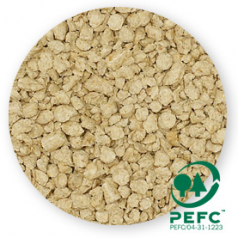




Most of the toys we use in our cattery are form the zaKatz range of toys. All kittens are conditioned to react to the zaBouncer, an indoor teaser that when thumped on the bed, has them running form all corners of the room to play on the bed.


The zaBird is a toy primarily for outside, that has a turning feather end and get’s any cat jumping to catch it. There are several different end pieces that can be used with the same rod.




That said, cats simple cardboard boxes and especially kittens, who still lose their baby teeth, love to chew on cardboard. Bottle tops, ping pong balls and anything they can bat around the floor keep them amused as well.
Note: elastic bands, string, cords from blinds, etc. can be deadly for kittens, please ensure you never have things they can swallow on the floor. Like human babies, kittens tend to put anything they find into their mouths.
Yes, this is normal behaviour for cats when they are happy. The kneading comes from when they were kittens and pushed with their front paws next to their mother’s teat to make the milk flow. Purring while kneading like this is a sign of complete happiness and being content.
Some cats, maybe 1 in 5, do this chattering when they see a bird and even holding a toy like the zaBouncer above them can cause that reaction. This is perfectly normal behaviour, they are just showing excitement at wanting to catch the bird, it is not a fit or abnormal behaviour.
No, not unless you are not providing your cat with sufficient scratch posts. All cats HAVE TO SCRATCH to sharpen their nails as well as pull out dead pieces of their nails. When cats scratch, they stand on their back legs and stretch up, so any scratch post or cat tree needs to be higher than the cat and have the rope they scratch on at the top. Some cat trees have fabric at the top and only rope in the middle, which is useless.
Cardboard scratching toys also work, there ones they can lay in or smaller ones they can stand on or that can be zip-tied to table leg. In a bigger house it makes sense to have 2-3 scratch posts, but it does not always have to be a cat tree, a simple scratch post works fine. If furniture is being scratched, shout at the cat, they know what you mean, and ensure a scratch post is close by. If that does not work, try a cat tree, cats will always climb up on that and will by default use the scratch ability offered.
Some scratch post are too narrow, it should have a diameter of minimum 10cm up 15cm to be comfortable for an adult cat.
Yes, cats that have access to a garden will use that to do their business, but will still want a litter tray when it rains or when they are locked up at night.
Cat’s want to dig when doing their business, so tend to go where the soil is softer. They also don’t want a dirty toilet, so will go to many different places. To prevent this and give our cats a clean toilet, we have created several outside toilets for our cats that they use during the day.
The outdoor toilets are at least 1m x 1m in size, dug out to 50cm and filled with sifted compost. Using the Cat’s Best cat litter and disposing of soiled litter in the compost produces great compost. Having sifted compost means the soil is soft and stays soft, so the cats will always go there. Every two days we clean out the toilets and remove the feces, every 4 weeks we change out the entire compost with new compost and throw the old soil back into the compost.
Cat’s are obligate carnivores and predators by nature and will cats rats, birds, rabbits, etc. and eat these completely. A natural diet for cats is primarily protein, they do not absorb carbs well like dogs, who are Omnivores. Raw meat is generally comprised of:
- 80% muscle meat
- 10% bones (minced or crushed)
- 5% liver
- 5% other organs
We start our kittens on minced whole rabbit when moving them to solids at around 5 weeks. By 8 weeks a kitten eat can an entire day-old chick and crunch on pieces of chicken neck. The bones in this meat bring out their hunting instinct and they growl, hiss and spit to protect their ‘prey’, which is very funny to watch.
What this shows however, even at this early age, is that hey are clearly predators with a very intact instinct.
Feeding RAW is no longer a problem in South Africa, there are several companies producing raw cat and dog food that is delivered to your home frozen and only needs to be thawed and fed to your pet. ArteKatz has been using the company Chefs4Pets for years to supply the raw cat food for our cattery and are one of the few suppliers that also provide day-old chicks, that all our cats get for breakfast. This is the cheapest and healthiest food and feeding raw is also cheaper than feeding a good brand kibble.
As an adult, a cat’s daily intake should be between 180g to 300g per day. Cats will not overeat on RAW food, as opposed to on commercial food. Food that is not eaten within 15 minutes should be taken up and stored in a refrigerator as part of the next meal. Adjust the amount fed according to the consumption,
The goal is to maintain the correct body weight for the breed and type of cat, so if your pet looses or gains weight, adjust the feeding quantity accordingly. Feeding once or twice a day is both acceptable and more down to personal preference. If twice a day, the % indicated above needs to be halved per meal. Kittens will normally be fed 3 meals a day until they are 9 months old.
This article by a vet in the US provides a good overview on raw feeding for cats.
Yes, despite some beliefs to the contrary, feeding them Raw and Kibble at the same time is possible and often the case when transitioning from Kibble to Raw. It is however not recommended to mix Raw and Kibble together.
Cat’s also do not like to have their raw food mixed, so if you provide your cat a variety of options as we do, keep them separated on the plate. Mixing minced heart and minced rabbit, two things all cats love, often causes them to not touch it – they are just fussy.
The point of feeding Raw is to provide your cat with a healthier diet and get it off the Kibble. If you want to continue feeding some Kibble, use them as treats instead of food.






